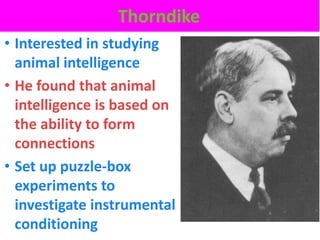
Trial & error learning Thorndike - VCE U4 Psych
- 1. Thorndike • Interested in studying animal intelligence • He found that animal intelligence is based on the ability to form connections • Set up puzzle-box experiments to investigate instrumental conditioning
- 2. Trial & Error learning - Thorndike • Describes an organism’s attempts to learn/solve a problem by trying alternative possibilities until a correct solution or desirable outcome is achieved Usually involves 1. A number of attempts & a number of errors - Before correct behaviour is learnt 2. Motivation (to achieve a goal) 3. Exploration – either random or purposeful 4. Reward – the correct response is rewarded – • which will lead to repeat performance of the correct response, strengthening the association between the behaviour & its outcome • Once learnt behaviour will usually be performed quickly and with fewer errors
- 3. Thorndike’s Puzzle-box experiment • Thorndike put a hungry cat in a ‘puzzle box’ & placed fish, just out of reach 1. At first the cat to escape from the box through trial & error (random voluntary movements) 2. Eventually the cat accidentally pulled the string, escaped from the box so that it could reach its reinforcement (the fish) • When the cat was put back in the box, once again it went through a series of incorrect responses before pushing the lever • The cat became progressively quicker at escaping (and had fewer incorrect behaviours)
- 4. Thorndike ‘Law of Effect’ • Thorndike concluded that the cat had learned the association between its behaviour (pulling the string) & the consequences (reaching the food) • Results led Thorndike to devise the ‘Law of effect’ that is a behaviour that is followed by a satisfying consequence is strengthened (more likely to happen) than a behaviour that is followed by an annoying consequence which is weakened (less likely to occur) • The food was a satisfying consequence – hence the cat would try to escape • Behaviour that kept the cat in the box (annoying consequence) was less likely to occur
